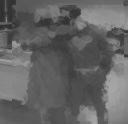I was just reading Leonardo a bedtime story, about a guy named Clark Kent. For fun, I said “Look up in the air, its a bird, its a plane, its SUPERCREST!” Leonardo got very upset He said, “I am tired of your students talking about Supercrest. Your students don’t know what they are talking about. There is no such hero as SUPERCREST. Show me a picture, see, you can’t. Supercrest is NOT real. What do you think he can do, wave himself back and forth. Ooohh, real scary. Superman is real. Read me a story about Superman.”
Yet, with all of this, Leonardo believes in the Easter Bunny. Of course, I would put Supercrest, Superman, Santa Claus, and the Easter Bunny all up there in the same category of Fringe Science, which makes a great TV show, but is hardly real. Speaking of Fringe, I was reading the most recent issue of Blick On Flicks. (by Jacob Blickenstaff, teacher education programs manager of the American Physical Society). He started out by writing about the Fringe, which (I will cite in orange) “The title is derived from the term “fringe science,” which is taken to mean topics like teleportation, time travel, telekinesis, extrasensory perception (ESP), and precognition.”
“All the episodes I have seen include some rather fanciful science and technology: a commercial airliner able to land on auto pilot, synchronization of two persons’ brains to “read” the mind of a comatose man, and improvising a defibrillator in less than 30 seconds. The series seems like a combination of CSI and The X-Files that is fun to watch, and has some potential for teachers to use as a starting point for interesting classroom discussions.
I think Fringe could be used most effectively to enlighten students about the definition of “science” and of scientific practice. Science fiction stories often extend or expand an idea from real science to heighten drama or to teach a lesson.”
Many people often ask me what I have against the way Science Fairs are so often run. They often use the “Scientific Method” which was made popular in the Sputnik error by the Ed Schools and has very little to do with the way science is the real world is actually conducted. Even worse is when it is used as a rubric for evaluating students. (I am sure I will get hate mail for that last statement). The method so often falsely taught is:

To further quote the same article:
“Science is defined not only by the topics scientists investigate, but also by the methods they use to conduct investigations. The “scientific method” as depicted on many science fair posters does not represent what scientists actually do: Very few real science projects follow the sequence question → research → hypothesis → experiment → conclusion (see the chart to the left). Instead, most scientific work is conducted in an iterative, rather than linear, fashion. (That iterative science is generally reported in a very linear format. It is easy to confuse the format of a scientific paper with the process of science that led to that report.)”
Blick goes on to say that Science is really done by something akin to the below diagram he got from the UC Berkeley web page. There is a great link there to a Flash animation. If the students look at the Flash Animation they might see elements of what we are trying to do here at BUA. Engage it collaboration, reading the primary literature, discussion of ideas, publication of ideas, comparing results of different experiments, etc.



